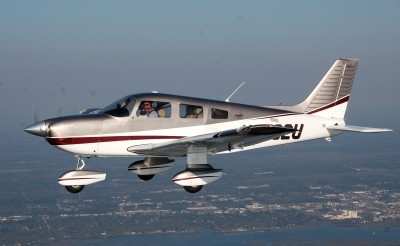Very Little That A Strong Economic Recovery Won't Fix
By Rich Belzer
In the aftermath of recent GA acquisitions – Piper by a
venture arm of the government of Brunei, Cirrus and Continental
Motors by AVIC (Aviation Industry Corporation of China), the huge,
Chinese-government-owned aviation company – a great deal of
concern has been expressed over the general health of GA. Of
course, the impact of the recession which hit in full force in
September, 2008, hit GA perhaps harder than any other industry.
After a slow 2008 reduced deliveries by 12%, deliveries dropped a
whopping 48% in 2009 followed by an additional 14% in 2010 (ref:
GAMA statistics for propeller aircraft deliveries).
No GA company was immune to the effects of the recession. Piper,
which has probably fared best among a group that includes Cessna,
Cirrus, Diamond, Hawker Beechcraft and Mooney, delivered 65% fewer
aircraft in 2009 than the prior year; even with a modest recovery
in 2010, Piper still delivered 45% less aircraft in 2010 than in
2008.
Piper 50th Anniversary Cherokee

What appears to be little understood by the aviation community
is the huge operating overhead inherent in the airplane
manufacturing business. Large factories and capital equipment are
intrinsic to building aircraft along with high levels of staffing.
During my years at Columbia Aircraft, we employed over 600 people
at our 2006 peak while delivering a modest 185 airplanes, mostly
the speedy Columbia 400. So what happens to such companies when
there is a sudden 50% decline in deliveries from one year to the
next?
Obviously, lay-offs in the factory are a given although it can
be difficult to assess what will happen from quarter to quarter so
lay-offs tend to lag. If you lay off hundreds and then the business
picks up, you may be faced with a difficult training process as you
try to react and staff up once again. Such a process tends to
result in lay-offs occurring at a slower rate than that at which
deliveries are declining. And of course, in the GA business,
deliveries trigger immediate cash as no aircraft ever leaves the
factory until it has been paid for in full. The bottom line is that
the process of slowly scaling back employees generally leads to a
period of negative cash flow which quickly reduces cash
reserves.
What about other possible reductions to address declining cash
flows? Airport land leases are fixed as are facilities so it is
virtually impossible to cut in these areas. This leaves engineering
and sales/marketing organizations as the only potential targets for
cuts.

Most GA companies were able to reduce sales/marketing costs by
reducing the frequency of their advertising and cutting back on new
programs with their advertising agencies. But airshow expenditures
for Sun ‘n Fun, AirVenture (Oshkosh) and AOPA Summit are huge
and considered by most GA companies to be essential. Fortunately,
most GA companies employ dealers who receive discounts on new
aircraft they sell and are not a drain when business declines; the
most significant exception is Cirrus which maintained a direct U.S.
sales organization of over 20 and faced a unique dilemma. Cutting
sales staff is generally viewed as a sure way to further reduce
sales and can result in a death spiral of ever declining revenue
followed by further cuts in sales staff. Cirrus hung on and ate the
additional overhead but seems to have moved lately into reducing
sales staffing levels.
But the biggest area for potential savings for a GA company is
in engineering/development – particularly in new aircraft
certification programs which not only entail higher staffing levels
but sizeable capital outlays for tooling and prototypes. Given the
rapid decline in cash receipts which occurred throughout GA from
2008 through today, is it any wonder that Cirrus, Diamond and Piper
put their respective jet programs on hold? When revenue is
declining faster than you can cut back, the first action you take
is to delay paying your vendors. The second is to eliminate any
non-essential capital outlays and nothing I can think of up sucks
up capital like development of a new aircraft.
As of today, however, all three jet programs are back on track.
How did this happen and what does it mean for our GA industry?
Piper Altaire

Piper was first. The only U.S.-owned of the three companies
developing new small jets, its owner, American Capital, having
somewhat rejuvenated Piper, was shopping for a buyer. As of
mid-2007, they had held controlling interest in the company longer
than planned and were having trouble finding a deep-pockets
investor to take them out. Along came Brunei, a small (600,000
people) but wealthy Asian country, located on the island of Borneo
and possessing significant oil and gas reserves. The Sultan of
Brunei, “owner” of the country and one of the
world’s wealthiest individuals, was looking to diversify and
his interest in Piper was to move his country into GA for the
long-term. Brunei’s venture arm, Imprimis, not only bought
out ACAS but invested in the PiperJet program so it did not need to
be funded out of current revenue. Piper, with its new and highly
professional management team, has been able to maintain its
operations on a cash-neutral basis but could clearly not be funding
their jet program without the additional capital from Imprimis.
The Cirrus situation was not altogether different from Piper
although their majority owner, Arcapita, was the U.S.-based
investment arm of the Bank of Bahrain. So Cirrus, although
headquartered in Duluth, Minnesota, was already an “offshore
company” when the recession hit. In similar fashion to Piper,
Cirrus delivered 47% fewer aircraft in 2010 than in 2008, laid off
hundreds of factory workers, delayed payments to vendors and put
their Vision jet program on hold. Arcapita, unwilling to invest
further in the company, actively sought an investor to take them
out, finding an interested AVIC in early 2010. Negotiations took
significantly longer than expected placing further cash pressure on
the company but the acquisition finally closed this summer.
For some reason, there was far more uproar in the U.S. GA
community over the Cirrus acquisition than over Piper which had
actually been U.S.-owned. The good news for Cirrus, however, is
that AVIC is already an aviation company and their investment in
Cirrus seems to be with a long-term view. As with Piper and
Imprimis, AVIC is already providing funding for the Cirrus jet
program which is back on track.
Diamond DA42 NG

Diamond, an Austrian Company owned by the notably wealthy
Christian Dries and with operations in London, Ontario in addition
to Austria, was forced to shut down its D-Jet program, in spite of
Dries’s deep pockets. Diamond has not fared as well as either
Piper or Cirrus during the recession and experienced a 59% drop in
deliveries between 2008 and 2010. Of late, an undisclosed investor
has injected cash into their jet program and it appears to have
resumed development.
Obviously, the recession has wreaked havoc in GA as both
disposable income and net worth have taken a big hit although the
stock market’s recovery over the past year-and-a-half has
helped restore a significant portion of investor losses. In
addition, though, businesses likely to purchase aircraft, both
large and small, continue to operate on a conservative basis as our
sluggish recovery continues. The reality is that, given the high
overhead needed to maintain an aircraft manufacturing company, a
massive recession such as we have experienced will put everyone
under stress. Looking around, each of companies I have discussed
has dealt with the situation and not only remained afloat but
managed to come up with an influx of capital that has rejuvenated
their development programs. The lone casualty over this period
appears to be Mooney which has been a financially marginal company
for some time.
But there is a common thread which has emerged over the past few
years which is of concern – few of our U.S. GA companies are
owned within the U.S. And the reason for this is a simple
one: U.S. venture firms are not interested in GA in a way,
shape or form. Why is this when it seems as if there is so much
offshore money finding our industry?
Simply put, the U.S. investment mentality, especially within the
venture community, fears long-term commitment, especially if the
capital requirements are high. (Energy development seems to be the
only exception to this but potential returns are significantly
higher than in GA.) Development of a new GA aircraft which
might sell for $2.5 million or less is a three-to-four year effort
and can take anywhere from $50 to $120 million, depending on the
size of the airplane. Given the slow ramp-up entailed in aircraft
manufacturing, obtaining a return-on-investment acceptable to an
investor is a six-to-seven year process, a long time for a U.S.
investor to have that much cash at risk. I should add that these
numbers don’t change much whether such a program is attempted
by an existing company or a start-up.

To add to the problem, Vern Raburn (Eclipse) and Rick Adam (Adam
Aircraft) raised huge amounts of investment capital to fund their
respective airplane companies. When both failed, high-net-worth
investors across the country were left with a bad taste in their
mouths when it comes to throwing cash into GA ventures.
I recall a quote from Carrie Fisher’s book Postcards from
the Edge to the effect that “instant gratification
isn’t fast enough”. Compared with the long-term view
taken in China for instance, this philosophy certainly applies to
the U.S. investment community. For this reason, I have little
optimism that companies such as Piper and Cirrus will ever again be
U.S.-owned. This pretty much leaves Cessna and Hawker Beechcraft
(although it is difficult to ascertain whether or not they are
owned in the U.S. or U.K.) as the only major players in GA that are
not owned offshore (not counting Gulfstream, of course).
But all is not lost for U.S. pilots. We continue to have the
friendliest skies in the world for GA pilots and most lenient for
pilot licenses and instrument ratings remain easy to obtain
relative to the process in other countries. As of today, the U.S.
market represents roughly 50% of the worldwide GA market although I
expect significant growth in China over the next ten years to erode
that lead.
So we can all rejoice in having a great country in which to fly,
even if we’ll mostly be flying “foreign”
aircraft.
Rich Belzer has been a pilot for 25 years as well as an
aircraft owner, holding a commercial license with an instrument
rating. Following 35 years in the computer industry, ten in senior
executive positions, he joined Columbia Aircraft in 2004 as
national sales manager. While at Columbia, he established all of
their international distribution and eventually was granted full
responsibility for worldwide distribution as the company’s
sales vice president. He has been interviewed numerous times by
written and broadcast media on aviation business issues and written
a number of earlier articles on the Columbia Aircraft bankruptcy
for Aero-News Network.
 ANN's Daily Aero-Linx (04.15.24)
ANN's Daily Aero-Linx (04.15.24) Classic Aero-TV: 'No Other Options' -- The Israeli Air Force's Danny Shapira
Classic Aero-TV: 'No Other Options' -- The Israeli Air Force's Danny Shapira Aero-News: Quote of the Day (04.15.24)
Aero-News: Quote of the Day (04.15.24) Airborne 04.16.24: RV Update, Affordable Flying Expo, Diamond Lil
Airborne 04.16.24: RV Update, Affordable Flying Expo, Diamond Lil ANN's Daily Aero-Term (04.16.24): Chart Supplement US
ANN's Daily Aero-Term (04.16.24): Chart Supplement US







